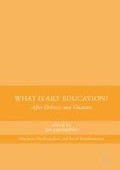Abstract
Organised around ten theses, this two-part essay sustains that art education’s viability comes from the autonomous specificity of art and the singularity of education. It rejects schooled art, while it asserts art as a form of unlearning. As unlearning, art education is an agôn where pedagogy ties desire to knowledge. This reveals the fallacy of education as a system of coherent necessities. Art’s autonomy means that art emerges and approaches the world as a dialectical state of affairs, where art and education become moments of hegemony. Yet hegemony will only prevail if its contingent conditions are preserved within a universality of particulars. This is only attained when art and education are sustained as empty signifiers that reject the myths of measure and correspondence.
Access this chapter
Tax calculation will be finalised at checkout
Purchases are for personal use only
Reference
Adorno, T. W., & Goldmann, L. (1977). To describe, understand and explain. In L. Goldmann (Ed.), Cultural creation in modern society. Oxford: Blackwell.
Baldacchino, J. (2012). Art’s Way out: Exit pedagogy and the cultural condition. Dordrecht: Sense Publishers.
Baldacchino, J. (2015a). ART ± EDUCATION: The paradox of the ventriloquist’s soliloquy. Sisyphus: Journal of Education, 3(1), 55–71.
Baldacchino, J. (2015b). Art’s foreignness as an ‘exit pedagogy’. In T. Lewis & M. Laverty (Eds.), Art’s teachings, teaching’s art: Philosophical, critical and educational musings, Contemporary philosophies and theories in education (Vol. 8, pp. 19–31). Netherlands: Springer. doi:10.1007/978-94-017-7191-7_2.
Baldacchino, J. (text), & Diggle, J. (images). (2002). Avant-nostalgia. And excuse to pause. Aberdeen: Robert Gordon University.
Barthes, R. (1973). Mythologies. London: Paladin.
Derrida, J. (1994). Aporias (T. Dutoit, Trans.). Stanford: Standford University Press.
Dewey, J. (1905). The realism of pragmatism. The Journal of Philosophy, Psychology and Scientific Methods, 2(12), 324–327.
Dewey, J. (2000). Liberalism and social action. Amherst: Prometheus Books.
Eco, U. (1986). Art and beauty in the middle ages (H. Bredin, Trans.). London: Yale University Press.
Goethe, J. W. (1987). Theory of colours. Cambridge, MA: MIT Press.
Gombrich, E. H. (1978). The story of art. London: Phaidon.
Gramsci, A. (1975). Il Materialismo Storico e la Filosofia di Benedetto Croce. Editori Riuniti: Torino.
Greene, M. (1988). The dialectic of freedom. New York: Teachers College Press.
Heaney, S. (1998). Opened ground, poems 1966–1996. London: Faber and Faber.
Hegel, G. W. (1975). Hegel’s aesthetics. Lectures on fine art (T.M. Knox, Trans.) (Vol. 1). London: Oxford University Press.
Hegel, G. W. (1989). Hegel’s logic, being part one of the encyclopaedia of the philosophical sciences (W. Wallace, Trans.). London: Clarendon Press/Oxford University Press.
Heidegger, M. (1987). An introduction to metaphysics (R. Mannheim, Trans.). London: Yale University Press.
Hippocrates. (n.d.). Aphorisms (F. Adams, Trans.). In The Internet classics archive. Online at http://classics.mit.edu//Hippocrates/aphorisms.html. Accessed 10 Nov 2015.
Horkheimer, M. (1974). Eclipse of reason. New York: Continuum.
Illich, I. (2009a). Tools for conviviality. New York: Marion Boyars.
Illich, I. (2009b). Shadow work. New York: Marion Boyars.
Kant, I. (1974). Critique of Judgement (J. H. Bernard, Trans.). New York: Hafner Press/Collier-Macmillan Publishers.
Kierkegaard, S. (1974). The sickness unto death. In S. Kierkegaard (Ed.), Fear and trembling and the sickness unto death. Published as one volume. W. Lowrie (Ed.). Princeton: Princeton University Press.
Kundera, M. (1991). Immortality (P. Kussi, Trans.). Faber and Faber: London.
Laclau, E. (1993). Politics and the limits of modernity. In T. Docherty (Ed.), Postmodernism a reader. London: Harvester Wheatsheaf.
Laclau, E. (1996). Emancipation(s). London: Verso.
Laclau, E. (1999). Hegemony and the future of democracy: Ernesto Laclau’s political philosophy. Lynn Worsham and Gary A. Olson (interviewers). Journal of Advanced Composition, 19(1), 1–34.
Leibniz, G. W. (1995). Monadology. In G. H. R. Parkinson (Ed.), Philosophical writings. London: Everyman.
Lukács, G. (1971). Prolegomeni a un’ Estetica Marxista, Sulla categoria della particolarità. Rome: Editori Riuniti.
Lyotard, J-F. (1988). The differend, phrases in dispute (G. Van Den Abeele, Trans.). Manchester: Manchester University Press.
Mahfouz, N. (1998). Echoes of an autobiography (D. Johnson-Davies, Trans.). New York: Anchor Books.
Marcuse, H. (2002). One-dimensional man. New York: Routledge.
Morante, E. (1970). Il beato propagandista del Paradiso. In L’Opera Completa dell’Angelico. Milano: Rizzoli.
Nagel, T. (1986). The view from nowhere. Oxford: Oxford University Press.
Nagel, T. (1991). Mortal questions. Cambridge: Cambridge University Press.
Nisbet, H. B. (1972). Goethe and the scientific tradition. London: Institute of Germanic Studies, University of London.
Pinter, H. (1999). The homecoming. London: Faber and Faber.
Plato. (1989). Symposium. In E. Hamilton & H. Cairns (Eds.), Plato, collected dialogues. Princeton: Princeton University Press.
Poole, R. (1993). Kierkegaard. The indirect communication. Charlottesville: University Press of Virginia.
Quine, W. V. (1987). Quddities. An intermittently philosophical dictionary. London: The Belknap Press of Harvard University Press.
Schutz, A. (1970). On phenomenology and social relations. Chicago: University of Chicago Press.
Searle, J. R. (1995). The construction of social reality. London: Allen Lane, The Penguin Press.
Seferis, G. (1981). Collected poems (E. Keeley & P. Sherrard, Trans.). Princeton: Princeton University Press.
Vico, G. (1998). On the most ancient wisdom of the Italians. Ithaca: Cornell University Press.
Wittgenstein, L. (1980). Wittgenstein’s Lectures. Cambridge, 1930–1932 (D. Lee, Ed.). Oxford: Basil Blackwell.
Wittgenstein, L. (1990). Remarks on colour (G. E. M. Anscombe, Ed., L. L. McAlister & M. Schättle, Trans.). Oxford: Basil Blackwell.
Wittgenstein, L. (1992). Tractatus Logico-Philosophicus (C. K. Ogden, Trans.). London: Routledge.
Author information
Authors and Affiliations
Editor information
Editors and Affiliations
Copyright information
© 2017 The Author(s)
About this chapter
Cite this chapter
Baldacchino, J. (2017). Art’s Ped(ago)gies. In: jagodzinski, j. (eds) What Is Art Education?. Education, Psychoanalysis, and Social Transformation. Palgrave Macmillan, New York. https://doi.org/10.1057/978-1-137-48127-6_8
Download citation
DOI: https://doi.org/10.1057/978-1-137-48127-6_8
Published:
Publisher Name: Palgrave Macmillan, New York
Print ISBN: 978-1-137-48126-9
Online ISBN: 978-1-137-48127-6
eBook Packages: EducationEducation (R0)

